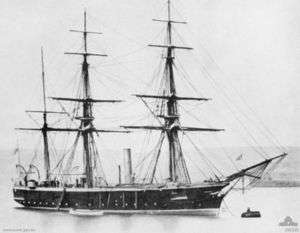HMS Penguin (1876)
 HMS Penguin | |
| History | |
|---|---|
| Name: | HMS Penguin |
| Builder: | Robert Napier and Sons, Govan |
| Cost: |
|
| Yard number: | 342 |
| Laid down: | 14 July 1874 |
| Launched: | 25 March 1876 |
| Commissioned: | 23 August 1877 |
| Recommissioned: | 1886 |
| Decommissioned: | 1889 |
| Recommissioned: | 1890 |
| Decommissioned: | 1908 |
| Fate: | Transferred to Australian service |
| Name: | HMAS Penguin |
| Acquired: | 1908 |
| Commissioned: | 1 July 1913 |
| Decommissioned: | 1924 |
| Fate: | Converted to crane hulk in 1924 |
| General characteristics | |
| Class and type: | Osprey-class screw composite sloop |
| Displacement: | 1,130 long tons (1,150 t) |
| Length: | 170 ft (51.8 m) (p/p) |
| Beam: | 36 ft (11.0 m) |
| Draught: | 15 ft 9 in (4.8 m) |
| Depth: | 19 ft 6 in (5.9 m) |
| Installed power: |
|
| Propulsion: |
|
| Sail plan: | Barque rig |
| Speed: | 11 knots (20 km/h; 13 mph) |
| Range: | 1,120 nmi (2,070 km; 1,290 mi) at 10 knots (19 km/h; 12 mph) |
| Complement: | 140 |
| Armament: |
|
HMS Penguin was an Osprey-class sloop. Launched on 1876, Penguin was operated by the Royal Navy from 1877 to 1881, then from 1886 to 1889. After being converted to a survey vessel, Penguin was recommissioned in 1890, and operated until 1908, when she was demasted and transferred to the Australian Commonwealth Naval Forces for use as a depot and training ship in Sydney Harbour. After this force became the Royal Australian Navy, the sloop was commissioned as HMAS Penguin in 1913. Penguin remained in naval service until 1924, when she was sold off and converted into a floating crane. The vessel survived until 1960, when she was broken up and burnt.
Design and construction
Penguin was an Osprey-class sloop-of-war, with a composite hull design.[1] The ship had a displacement of 1,130 tons, was 170 feet (52 m) long, had a beam of 36 feet (11 m), and a draught of 15 feet 9 inches (4.80 m).[2][1] An R & W Hawthorn two-cylinder horizontal returning-rod steam engine fed by three cylindrical boilers provided 666 indicated horsepower to the single 13 ft (4.0 m) propeller screw.[1] This gave Penguin a top speed of 9.9 knots (18.3 km/h; 11.4 mph), which failed to meet the required contract speed. After the first commission the engine was replaced by a Devonport Dockyard two-cylinder horizontal compound-expansion steam engine, developing 951 indicated horsepower (709 kW). She had a maximum range of 1,480 nautical miles (2,740 km; 1,700 mi) at 10 kn (19 km/h; 12 mph).[1] In addition to the steam-driven propeller, the vessel was also barque rigged.[1] The standard ship's company was between 140 and 150.[1]
Armament consisted of two 7-inch (90cwt) muzzle-loading rifled guns, four 64-pound guns, four machine guns, and one light gun.[1]
Penguin was built by Robert Napier and Sons, of Govan, Scotland.[3] The vessel was laid down on 14 July 1876 as yard number 342.[1] She was launched on 25 March 1876,[3] and commissioned into the Royal Navy on 23 August 1877.[1] Construction costs included £39,611 for the hull, and £12,500 for her steam machinery.[1]
Operational history
British service
After entering service, Penguin was assigned to the Pacific Station until 1881, when she was paid off.[3] Recommissioned in 1886 for the East Indies Station, she formed part of Rear-Admiral Fremantle's Anti-Slave Trade Squadron[4] and participated in the blockade of Zanzibar in 1888 before returning to England and being paid off in 1889. She underwent a refit as a survey vessel and commenced service on the Australia Station in 1890 and undertook survey work around the Western Pacific islands, New Zealand and the Great Barrier Reef. From 1896 to 1899 she was under the command of Captain Arthur Mostyn Field and her surveying work included deep borings on Funafuti atoll.[5] Commander W. P. Dawson was appointed in command during summer 1902.[6]
Australian service
Her masts removed, she was transferred for harbour service at Sydney in 1908, before being commissioned into the RAN as HMAS Penguin, a depot ship, on 1 July 1913.[7]
Decommissioning and fate
Her hull was sold to Samuel Waugh Ltd and converted into a crane hulk at Sydney in 1924. Later sold for breaking up, her hull was burnt on 13 December 1960 at Kerosene Bay, Sydney.[1][3]
See also
Notes
References
- 1 2 3 4 5 6 7 8 9 10 11 12 Winfield, pp.291–292
- ↑ "Naval Sloops at battleships-cruisers.co.uk". Retrieved 2008-08-30.
- 1 2 3 4 Bastock, p.111.
- ↑ Fremantle to Admiralty, 10 September 1888 enclosed in Admiralty to Foreign Office, 9 October 1888, FO 403/107, The National Archives, UK.
- ↑ Admiral Sir Arthur Mostyn Field (1855–1950) from nmm.ac.uk
- ↑ "Naval & Military intelligence". The Times (36784). London. 3 June 1902. p. 10.
- ↑ "Royal Australian Navy History – HMAS Penguin". Retrieved 2010-09-19.
- Ballard, G. A. (1939). "British Sloops of 1875: The Larger Ram-Bowed Type". Mariner's Mirror. Cambridge, UK: Society for Nautical Research. 25 (January): 35–49.
- Bastock, John (1988), Ships on the Australia Station, Child & Associates Publishing Pty Ltd; Frenchs Forest, Australia. ISBN 0-86777-348-0
- Chesneau, Roger; Kolesnik, Eugene M., eds. (1979). Conway's All the World's Fighting Ships 1860–1905. Greenwich, UK: Conway Maritime Press. ISBN 0-8317-0302-4.
- Preston, Anthony; Major, John (2007). Send a Gunboat: The Victorian Navy and Supremacy at Sea, 1854–1904 (2nd ed.). London: Conway. ISBN 978-0-85177-923-2.
- Winfield, Rif & Lyon, David (2004). The Sail and Steam Navy List: All the Ships of the Royal Navy 1815–1889. London: Chatham Publishing. ISBN 978-1-86176-032-6. OCLC 52620555.